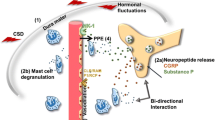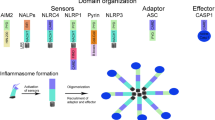Abstract
The pathogenesis of migraine is still unclear, but much evidence suggests a role of inflammation in pain generation. Calcitonin gene related peptide, nitric oxide and cytokines are all molecules shown to be involved both in animal and human studies. The glutamatergic system is also described as a possible mechanism leading to neuronal hyperexcitability and cortical spreading depression (CSD). Excitotoxic neural death, due to excessive release of the amino acid in the extracellular space, may represent a consequence of protracted CSD and oligaemia and may be involved in migrainous infarction and aspecific lesions seen on T2-weighted NMR imaging.
Similar content being viewed by others
Author information
Authors and Affiliations
Corresponding author
Rights and permissions
About this article
Cite this article
Longoni, M., Ferrarese, C. Inflammation and excitotoxicity: role in migraine pathogenesis. Neurol Sci 27 (Suppl 2), s107–s110 (2006). https://doi.org/10.1007/s10072-006-0582-2
Issue Date:
DOI: https://doi.org/10.1007/s10072-006-0582-2




